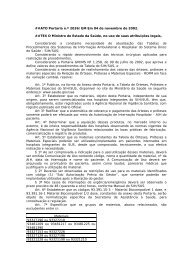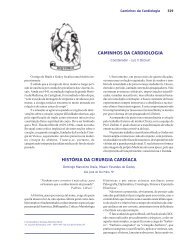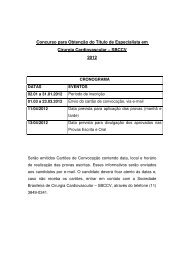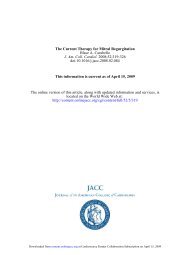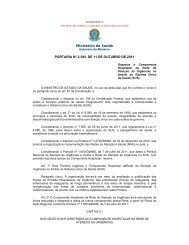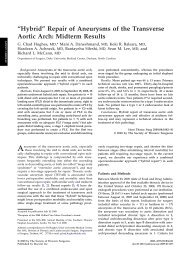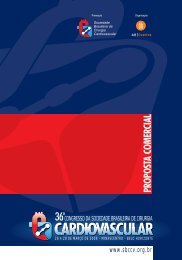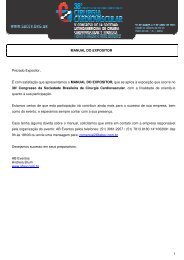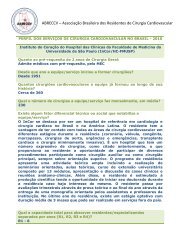Left ventricular assist device (LVAD)
Left ventricular assist device (LVAD)
Left ventricular assist device (LVAD)
Create successful ePaper yourself
Turn your PDF publications into a flip-book with our unique Google optimized e-Paper software.
Improved Survival and Decreasing Incidence of<br />
Adverse Events With the HeartMate II <strong>Left</strong><br />
Ventricular Assist Device as Bridge-to-Transplant<br />
Therapy<br />
Ranjit John, MD, Forum Kamdar, BS, Kenneth Liao, MD, Monica Colvin-Adams, MD,<br />
Andrew Boyle, MD, and Lyle Joyce, MD<br />
Division of Cardiothoracic Surgery, Department of Surgery, and Division of Cardiology, University of Minnesota, Minneapolis,<br />
Minnesota<br />
Background. Pulsatile left <strong>ventricular</strong> <strong>assist</strong> <strong>device</strong>s was 96.9% by Kaplan-Meier analysis; at 6 months (alive<br />
(<strong>LVAD</strong>s) are effective as bridge-to-transplant therapy, or transplanted), 86.9%. Major adverse events included<br />
but they are limited by their large size and lack of bleeding requiring reexploration in 5 patients (15.6%),<br />
durability. Smaller, more durable, continuous flow de- right <strong>ventricular</strong> failure requiring right <strong>ventricular</strong> <strong>assist</strong><br />
vices such as the HeartMate II <strong>LVAD</strong> are increasingly<strong>device</strong><br />
support in 2 (6.3%), <strong>LVAD</strong>-related infections in 4<br />
being used. The aim of this study is to report our (12.5%), neurologic or thromboembolic events in 2 (6.3%),<br />
single-center experience with this <strong>device</strong> as bridge-to- and gastrointestinal bleeding in 5 (15.6%). We noted one<br />
transplant therapy.<br />
serious <strong>device</strong> malfunction (3.1%) resulting in the pa-<br />
Methods. Overall, 47 patients received HeartMate II tient’s death; in addition, 2 patients experienced pump<br />
<strong>LVAD</strong>s at our center from June 2005 to July 2007; 32 as thrombosis (6.3%).<br />
bridge to transplant, 7 as destination therapy, and 8 as Conclusions. Despite morbidity, use of the HeartMate<br />
exchange therapy for a failed HeartMate XVE. We re- II <strong>LVAD</strong> as bridge-to-transplant therapy is associated<br />
viewed our experience with the <strong>device</strong> as bridge-to- with excellent survival and low mortality rates. We<br />
transplant therapy and report on patient survival and found a marked decrease in morbidity related to right<br />
adverse events.<br />
<strong>ventricular</strong> failure, to <strong>device</strong>-related infections, and to<br />
Results. The mean age of the bridge-to-transplant pa- thromboembolic events. However, the requirements<br />
tients was 50.75 � 13.78 years; 10 (31.3%) were female. for anticoagulation therapy may be associated with<br />
The cause of the underlying disease was ischemic in 18increased<br />
mediastinal and gastrointestinal bleeding.<br />
patients (56.3%), idiopathic in 11 (34.4%), myocarditis in Strategies to optimize anticoagulation therapy may fur-<br />
1 (3.1%), postpartum cardiomyopathy in 1 (3.1%), and ther improve results for these critically ill patients.<br />
congenital heart disease in 1 (3.1%). The mean duration<br />
of HeartMate II support was 193.2 � 139.9 days. At 30<br />
(Ann Thorac Surg 2008;86:1227–35)<br />
days after HeartMate II placement, the patient survival<br />
© 2008 by The Society of Thoracic Surgeons<br />
<strong>Left</strong> <strong>ventricular</strong> <strong>assist</strong> <strong>device</strong> (<strong>LVAD</strong>) placement is an<br />
accepted treatment for patients with end-stage heart<br />
failure [1]. The increased applicability and excellent results<br />
with <strong>LVAD</strong>s has revolutionized the treatment options<br />
available for the patient with end-stage heart failure.<br />
Most patients who have undergone <strong>LVAD</strong><br />
implantation as bridge-to-transplant (BTT) therapy have<br />
been supported by pulsatile, volume-displacement <strong>device</strong>s<br />
such as the HeartMate XVE (Thoratec, Pleasanton,<br />
California), the Novacor <strong>LVAD</strong> (WorldHeart, Oakland,<br />
California), or the Thoratec VAD (Thoratec) [2–6]. Suc-<br />
Accepted for publication June 2, 2008.<br />
Presented at the Forty-fourth Annual Meeting of The Society of Thoracic<br />
Surgeons, Fort Lauderdale, FL, Jan 28–30, 2008.<br />
Address correspondence to Dr John, Division of Cardiothoracic Surgery,<br />
University of Minnesota, 420 Delaware St SE, MMC 207, Minneapolis,<br />
MN 55455; e-mail: johnx008@umn.edu.<br />
cess with those <strong>device</strong>s for BTT therapy has led to their<br />
successful use as an alternative altogether to a transplant,<br />
namely, as destination therapy [7]. While tremendous<br />
success has been achieved with these <strong>device</strong>s, their use is<br />
associated with significant comorbidity, which may be<br />
related to several factors including the need for extensive<br />
surgical dissection, a large pump, and a large-diameter<br />
percutaneous lead. Even more important, their long-term<br />
durability is limited, frequently requiring reoperations<br />
for <strong>device</strong> exchange, which often result in significant<br />
morbidity and mortality.<br />
The new HeartMate II <strong>LVAD</strong>, which incorporates continuous<br />
flow, rotary pump technology, represents the<br />
Dr Boyle discloses that he has a financial relationship<br />
with Thoratec.<br />
© 2008 by The Society of Thoracic Surgeons 0003-4975/08/$34.00<br />
Published by Elsevier Inc doi:10.1016/j.athoracsur.2008.06.030<br />
ADULT CARDIAC
ADULT CARDIAC<br />
1228 JOHN ET AL Ann Thorac Surg<br />
HEARTMATE II <strong>LVAD</strong> AS BRIDGE-TO-TRANSPLANT 2008;86:1227–35<br />
Fig 1. External view of HeartMate II left <strong>ventricular</strong> <strong>assist</strong> <strong>device</strong>.<br />
(Illustration © Thoratec Corporation. Reproduced with permission.)<br />
next generation of <strong>device</strong>s [8, 9]. The simpler design of<br />
continuous flow, rotary pump technology promises greater<br />
long-term mechanical reliability, with a single moving part:<br />
the internal rotor (Figs 1 and 2). The HeartMate II <strong>LVAD</strong> is<br />
one seventh the size and one fourth the weight of the<br />
previous HeartMate XVE. We report our single-center<br />
experience, discussing survival and adverse events with<br />
the HeartMate II <strong>LVAD</strong> as BTT therapy in 32 patients<br />
with end-stage heart failure at the University of Minnesota<br />
Medical Center.<br />
Material and Methods<br />
Patients<br />
From June 2005 through July 31, 2007, a total of 47<br />
patients underwent HeartMate II placement at the University<br />
of Minnesota Medical Center: 32 as BTT therapy,<br />
7 as destination therapy, and 8 as exchange therapy for a<br />
Fig 2. Cross-sectional internal view of Heart-<br />
Mate II left <strong>ventricular</strong> <strong>assist</strong> <strong>device</strong>. (Illustration<br />
© Thoratec Corporation. Reproduced<br />
with permission.)<br />
failed XVE. The mean duration of HeartMate II support<br />
was 193.2 � 139.9 days.<br />
Our study focuses on the 32 BTT patients. All 32 study<br />
patients were part of a prospective, multicenter study<br />
evaluating the use of the HeartMate II <strong>LVAD</strong> as BTT<br />
therapy. Patients with end-stage heart failure who were<br />
on our transplant waiting list were eligible for study<br />
enrollment. The protocol for the study was approved by<br />
the Food and Drug Administration and by our own<br />
center’s Institutional Review Board. Patient consent for<br />
data collection and for reporting was obtained by a<br />
standard informed consent process. (Detailed inclusion<br />
and exclusion criteria are listed in the Supplementary<br />
Appendix, available with the referenced article at www.<br />
nejm.org [10].)<br />
HeartMate II<br />
The HeartMate II consists of an internal blood pump with<br />
a percutaneous lead that connects the pump to an external<br />
system driver and power source. The pump has an<br />
implant volume of 63 mL and generates up to 10 L/min of<br />
flow at a mean pressure of 100 mm Hg. Details of<br />
HeartMate II function and the implantation technique<br />
have been described elsewhere [8, 9].<br />
The implantation technique at the University of<br />
Minnesota is briefly summarized here. To implant the<br />
HeartMate II, a median sternotomy is performed. The<br />
patient is placed on cardiopulmonary bypass, with aortic<br />
and right atrial cannulation. The inflow cannula is inserted<br />
into an opening made in the apex of the left<br />
ventricle with a coring knife. A circular Teflon (Impra,<br />
subsidiary of L.R. Bard, Tempe, Arizona) pledget in the<br />
shape of a donut is placed around the <strong>ventricular</strong> apical<br />
core. Then, 2-0 Tevdek mattress sutures are used to<br />
secure the inflow cuff to the ventricle using the circular<br />
Teflon strip. After a side-biting clamp is placed in the<br />
midportion of the ascending aorta, the outflow graft is<br />
sewn to a longitudinal aortotomy. The pump is surgically<br />
placed in a preperitoneal pocket at the level of the
Ann Thorac Surg JOHN ET AL<br />
2008;86:1227–35 HEARTMATE II <strong>LVAD</strong> AS BRIDGE-TO-TRANSPLANT<br />
diaphragm. After the patient is weaned off cardiopulmonary<br />
bypass, support with the HeartMate II pump is<br />
initiated. Adequate flows are achieved, both by adjusting<br />
pump speed and by ensuring adequate preload and<br />
appropriate inotropic support. Protamine is administered<br />
to reverse the effects of heparin. After meticulous hemostasis<br />
is achieved, the chest is closed with appropriately<br />
placed chest tubes.<br />
Device Management<br />
Per our local practice at the University of Minnesota, we<br />
set the revolutions per minute (RPM) rate of the Heart-<br />
Mate II to provide adequate cardiac output and achieve<br />
optimal left <strong>ventricular</strong> decompression, while maintaining<br />
a pulsatility index greater than 3.5 to 4. In addition,<br />
we usually adjust the fixed-rate speed of the HeartMate II<br />
to maximize left <strong>ventricular</strong> decompression and to improve<br />
cardiac output, simultaneously allowing for at least<br />
a 1:3 ratio of aortic valve opening. We optimize the RPM<br />
speed, both hemodynamically and echocardiographically,<br />
at the time of <strong>LVAD</strong> placement, before the patient<br />
is discharged from the hospital (ie, after admission for<br />
<strong>LVAD</strong> placement), and if clinical events (eg, new symptoms<br />
or suction events) warranted further adjustment.<br />
All 32 study patients were on a standard regimen of<br />
heart failure therapy, including antiarrhythmic therapy<br />
(our usual practice). Anticoagulation therapy involved a<br />
combination of warfarin and aspirin. After <strong>LVAD</strong> placement,<br />
we did not change defibrillator and bi<strong>ventricular</strong><br />
pacing settings. All patients underwent a standard postoperative<br />
rehabilitation program.<br />
Data Collection<br />
We collected baseline and follow-up data, including<br />
patient characteristics, blood chemistry analyses, hematologic<br />
findings, neurologic status, and concomitant medication<br />
use. After patients were discharged from the<br />
hospital to home, they returned to our center for followup,<br />
<strong>device</strong> review, and general status assessment—<br />
weekly for the first 4 weeks, and then monthly until the<br />
study endpoint. We recorded hospital readmissions and<br />
patient adverse events (including suspected <strong>device</strong> malfunctions)<br />
throughout the study as they occurred, using<br />
standardized definitions [10].<br />
Anticoagulation Therapy<br />
For our study, we agreed on this six-step initial anticoagulation<br />
regimen as a guideline: (1) initiation of an<br />
intravenous infusion of unfractionated heparin 12 to 24<br />
hours after HeartMate II placement or at the point that<br />
thoracostomy tube drainage was less than 50 mL/hour;<br />
(2) titration of the heparin infusion to a partial thromboplastin<br />
time (PTT) of 45 to 50 s for 24 hours after<br />
placement; (3) after 24 hours, titration of the heparin<br />
infusion to a PTT goal of 50 to 60 s; (4) after an additional<br />
24 hours, titration of the heparin infusion to a PTT goal of<br />
55 to 65 s; (5) initiation of antiplatelet therapy on postoperative<br />
day 2 to 3 (aspirin 81 mg daily); and (6) on<br />
postoperative day 3 to 5 and after removal of thoracostomy<br />
tubes, initiation of anticoagulation with warfarin,<br />
titrating the dose to an international normalized ratio<br />
(INR) of 2 to 3 and discontinuing heparin after obtaining<br />
a therapeutic INR.<br />
However, as a result of significant gastrointestinal (GI)<br />
bleeding in 3 patients and delayed pericardial tamponade<br />
in 1 patient (among the first 14 patients), we decided<br />
to stop using postoperative heparin in all subsequent<br />
patients. Further, we decided to initiate anticoagulation<br />
therapy with warfarin (starting on postoperative day 3),<br />
titrating the dose to an INR of 1.5 to 2.<br />
Statistical Analysis<br />
We prospectively collected and retrospectively analyzed<br />
all data. Results are presented as mean values � SD. A<br />
p value less than 0.05 was considered statistically significant.<br />
To calculate survival, we performed Kaplan-Meier<br />
analysis. For all data, we used SPSS 11.5 (SPSS, Chicago,<br />
Illinois).<br />
Results<br />
Patient Characteristics<br />
Of 47 patients, 32 underwent HeartMate II placement as<br />
BTT therapy; 7, as destination therapy; and 8, as exchange<br />
therapy for a failed HeartMate XVE. The mean<br />
age of the 32 BTT patients was 50.7 � 13.7 years. Among<br />
the BTT patients, the cause of heart failure was ischemic<br />
in 56.3% (n � 18) and idiopathic in 33.4% (n � 11); 1<br />
patient had congenital heart disease, 1 had postpartum<br />
cardiomyopathy, and 1 had myocarditis. The overall<br />
mean duration of HeartMate II support in the BTT group<br />
was 193.2 � 139.9 days.<br />
The baseline characteristics of the 32 BTT patients are<br />
summarized in Table 1. One patient did not meet inclusion<br />
criteria for the study and an exemption was obtained<br />
from the Institutional Review Board. That patient was a<br />
Table 1. Patient Characteristics at Baseline (n � 32)<br />
1229<br />
Mean age (years) 50.75 � 13.78 (range, 23–70)<br />
Male:female ratio<br />
Cause of heart failure<br />
2.2:1<br />
Ischemic 18 (56.3%)<br />
Idiopathic 11 (34.4%)<br />
Postpartum cardiomyopathy 1 (3.1%)<br />
Myocarditis 1 (3.1%)<br />
Congenital 1 (3.1%)<br />
Diabetes mellitus 11 (34.4%)<br />
Hypertension 11 (34.4%)<br />
Coronary artery disease 18 (56.3%)<br />
Myocardial Infarction 18 (56.3%)<br />
PTCA/PCI 12 (37.5%)<br />
CABG 10 (31.3%)<br />
Body mass index 27.3 (range 15.43–44)<br />
Duration of <strong>LVAD</strong> support<br />
(days)<br />
193.17 � 139.96 (range, 10–644)<br />
CABG � coronary artery bypass graft surgery; <strong>LVAD</strong> � left <strong>ventricular</strong><br />
<strong>assist</strong> <strong>device</strong>; PTCA � percutaneous transluminal coronary angioplasty;<br />
PCI � percutaneous coronary intervention.<br />
ADULT CARDIAC
ADULT CARDIAC<br />
1230 JOHN ET AL Ann Thorac Surg<br />
HEARTMATE II <strong>LVAD</strong> AS BRIDGE-TO-TRANSPLANT 2008;86:1227–35<br />
Table 2. Hemodynamic Variables at Baseline (n � 31)<br />
Data Mean � SD<br />
Systolic arterial pressure (mm Hg) 103.9 � 14.7<br />
Diastolic arterial pressure (mm Hg) 68.7 � 10.5<br />
Systolic PAP (mm Hg) 56.52 � 13.41<br />
Diastolic PAP (mm Hg) 28.19 � 6.23<br />
Right atrial mean (mm Hg) 14.17 � 5.27<br />
PCWP (mm Hg) 24.45 � 5.90<br />
PVR (Woods units) 3.69 � 1.98<br />
Cardiac output (L/min) 3.96 � 1.20<br />
Cardiac index 1.99 � 0.47<br />
PAP � pulmonary artery pressure; PCWP � pulmonary capillary<br />
wedge pressure; PVR � pulmonary vascular resistance.<br />
23-year-old male who was transferred from an outside<br />
hospital with acute cardiogenic shock with multisystem<br />
organ failure and required urgent placement of bi<strong>ventricular</strong><br />
support with CentriMag Levitronix <strong>device</strong>s (Levitronix<br />
LLC, Waltham, MA). After failure to be weaned<br />
from temporary bi<strong>ventricular</strong> support, he underwent<br />
placement of a HeartMate II <strong>LVAD</strong>; he required right<br />
<strong>ventricular</strong> <strong>assist</strong> <strong>device</strong> (RVAD) support with the<br />
CentriMag <strong>device</strong> postoperatively.<br />
Hemodynamic Data<br />
Hemodynamic data at baseline for the BTT patients are<br />
shown in Table 2 (excluding the hemodynamic data of<br />
1 patient who received bi<strong>ventricular</strong> support before<br />
HeartMate II placement).<br />
End-Organ Function Data<br />
Serum markers of end-organ function before HeartMate<br />
II placement and at 3-month follow-up for the BTT<br />
patients are shown in Table 3.<br />
Outcomes<br />
The 30-day operative survival rate by Kaplan-Meier analysis<br />
was 95.6% (Fig 3). Of the 32 BTT patients, 1 patient<br />
died 10 days after HeartMate II placement from exsanguination<br />
related to subclavian vein hemorrhage after<br />
central venous line removal. The survival rate at 6<br />
months (alive or transplanted) was 86.9%. After the initial<br />
postoperative 1-month period, 2 patients died: 1 was<br />
Table 3. Serum Indicators of End-Organ Function at<br />
Baseline and at 3 Months (n � 32)<br />
Data Baseline 3 Months p Value<br />
Renal<br />
Creatinine 1.55 � 0.56 1.23 � 0.5 0.031<br />
Blood urea nitrogen<br />
Liver<br />
34.81 � 18.70 22.6 � 13.1 �0.001<br />
Alanine<br />
aminotransferase<br />
68.22 � 100.87 36.2 � 19.3 0.05<br />
Aspartate<br />
aminotransferase<br />
70.38 � 118.25 53.5 � 30 0.158<br />
Total bilirubin 1.31 � 0.83 0.78 � 0.5 �0.001<br />
Table 4. Outcomes on <strong>Left</strong> Ventricular Assist Device Support<br />
(n � 32)<br />
Outcomes Number<br />
Transplanted 19<br />
On the transplant waiting list 9<br />
Death 3<br />
Early deaths (�30 days)<br />
Subclavian vein hemorrhage 1 (day 10)<br />
Late deaths (�30 days)<br />
Device failure 1 (day 73)<br />
Multisystem organ failure 1 (day 42)<br />
doing well but died at home from sudden unexpected<br />
pump malfunction; 1 died in the hospital from septic<br />
complications with multisystem organ failure.<br />
Of the 32 BTT patients, 19 (59.4%) have now undergone<br />
a heart transplant after an average of 193 � 93.4 days;<br />
another 9 are doing well at home and awaiting a heart<br />
transplant. All 19 BTT patients who underwent a transplant<br />
were discharged to home. The 1 remaining patient<br />
who was alive and discharged to home was not eligible<br />
for a transplant because of postoperative paraplegia.<br />
Outcomes are detailed in Table 4. Adverse events occurring<br />
during HeartMate II support are outlined in Table 5.<br />
Neurologic or Thromboembolic Events<br />
During the entire period of HeartMate II support, we<br />
noted only 1 thromboembolic event (2.2%). This patient<br />
subsequently underwent a heart transplant and, as of the<br />
end of this study, is doing well. In addition, 1 patient had<br />
postoperative paraplegia, without any significant recovery.<br />
The cause of her paraplegia is unknown. It may be<br />
Table 5. Adverse Events on <strong>Left</strong> Ventricular Assist Device<br />
Support (n � 32)<br />
Adverse Event Number<br />
Neurologic or thromboembolic 2 (6.25%)<br />
Stroke 1 (3.12%)<br />
Paraplegia 1 (3.12%)<br />
Hemorrhagic<br />
Mediastinal bleeding requiring reexploration 5 (15.6%)<br />
Gastrointestinal bleeding 5 (15.6%)<br />
Infectious<br />
Driveline infection 4 (12.5%)<br />
Pump pocket infection 0<br />
Right <strong>ventricular</strong> failure 2 (6.25%)<br />
Requiring RVAD support 2 (6.25%)<br />
Requiring prolonged inotropic support 0<br />
Pump thrombosis 2 (6.25%)<br />
Device malfunction 1 (3.12%)<br />
Device replacement 0<br />
Renal failure 1 (3.12%)<br />
Respiratory failure 2 (6.25%)<br />
Hemolysis 1 (3.12%)<br />
RVAD � right <strong>ventricular</strong> <strong>assist</strong> <strong>device</strong>.
Ann Thorac Surg JOHN ET AL<br />
2008;86:1227–35 HEARTMATE II <strong>LVAD</strong> AS BRIDGE-TO-TRANSPLANT<br />
Fig 3. Actuarial survival (Kaplan-Meier analysis) of patients undergoing<br />
HeartMate II placement as bridge-to-transplant therapy.<br />
related to the perioperative hypotension that she had.<br />
She also had immediate right <strong>ventricular</strong> failure requiring<br />
temporary RVAD support for 1 week after<br />
HeartMate II placement with a significant pressor<br />
requirement. Thus, the overall incidence of adverse<br />
neurologic events was 2 of 32 (6.25%). Note that no<br />
transient ischemic attacks occurred in our group of 32<br />
HeartMate II patients. Also, none of the patients who<br />
discontinued warfarin experienced any thromboembolic<br />
events during HeartMate II support.<br />
Infections<br />
During the entire period of HeartMate II support, 4<br />
patients (12.5%) had driveline infections that required<br />
long-term intravenous and oral antibiotic therapy. Staphylococcus<br />
aureus was identified in 3 patients and Enterobacter<br />
species in 1 patient. The mean duration to onset of<br />
infection was 50.5 days. The infections resolved without<br />
any evidence of recurrence in all 4 patients. There were<br />
no <strong>LVAD</strong>-pocket infections in our experience.<br />
Right Ventricular Failure<br />
Severe right <strong>ventricular</strong> failure requiring placement of an<br />
RVAD occurred in 2 (6%) patients. Both patients required<br />
CentriMag Levitronix RVAD placement for immediate<br />
right <strong>ventricular</strong> failure (which occurred immediately<br />
after HeartMate II placement). In both patients, the<br />
RVAD was explanted within 1 week after placement.<br />
Both patients survived more than 6 months; 1 is awaiting<br />
a heart transplant. The other patient survived almost 2<br />
years after <strong>LVAD</strong> placement, but was not transplant<br />
eligible owing to the development of postoperative para-<br />
plegia. It should be noted that no additional patients<br />
required prolonged inotropic support. Thus, the overall<br />
incidence of right <strong>ventricular</strong> failure (as defined by<br />
RVAD requirement or intropic support � 14 days) was<br />
6%. An additional patient who required temporary<br />
RVAD support was not included here as he had right<br />
<strong>ventricular</strong> failure requiring RVAD support even before<br />
HeartMate II placement (discussed earlier).<br />
Hemorrhagic Complications<br />
Of the first 14 patients on the HeartMate II in our series<br />
who received heparin followed by warfarin, 3 had GI<br />
bleeding and 1 suffered delayed pericardial tamponade<br />
(4 of 14, 28.5%). Of the remaining 18 patients who<br />
received only warfarin and no heparin, 2 had GI bleeding,<br />
and none suffered pericardial tamponade (2 of 18,<br />
11.1%). Note that this part of the analysis excluded<br />
patients who underwent mediastinal exploration for<br />
bleeding on the day of surgery, because that was unrelated<br />
to postoperative anticoagulation therapy. In addition,<br />
5 patients (15.6%) had postoperative bleeding requiring<br />
mediastinal reexploration, with no resulting<br />
mortality.<br />
Device Thrombus<br />
Of our 32 BTT patients, 1 had a suspected pump thrombus<br />
that resolved with a high-intensity heparin anticoagulation<br />
protocol (the INR was 1.3 at the time of presentation). This<br />
patient had gone to an outside hospital with HeartMate II<br />
flows in the mid–3 L/min range (in contrast to this patient’s<br />
usual flows � 4 L/min) and with increased HeartMate II<br />
power. After 12 hours of high-intensity anticoagulation<br />
heparin therapy (target PTT, 60 s to 80 s), this patient’s<br />
hemodynamic indicators returned to normal. Heparin therapy<br />
was continued for 48 hours. Warfarin therapy was<br />
continued to achieve a goal INR of 1.5 to 2.0. No thrombolytic<br />
therapy was used. As of the end of this study, this<br />
patient is doing well on the heart transplant waiting list,<br />
without any further similar episodes 6 months after this<br />
suspected pump thrombus. Thus, our overall incidence of<br />
<strong>device</strong> thrombus was 2 of 32 (6 %), including 1 explanted<br />
pump that received a thrombus score of 3, as reported in<br />
the next section.<br />
Explanted Pump Analysis<br />
Fourteen patients in our study group whose HeartMate II<br />
was explanted (at the time of their heart transplant)<br />
underwent examination of their explanted pumps for<br />
thrombus deposition. All pumps except one received a<br />
thrombus score of 0 (none) or 1 (minimal). The one<br />
explanted pump that received a high score of 3 (� 50%<br />
obstruction with thrombus) had been in the patient who<br />
died after prolonged sepsis. He had several days of low<br />
pump flow preceding his death, which may have been<br />
associated with the development of pump thrombus.<br />
Comment<br />
1231<br />
The discrepancy between the limited availability of donor<br />
organs and the ever-increasing number of patients<br />
ADULT CARDIAC
ADULT CARDIAC<br />
1232 JOHN ET AL Ann Thorac Surg<br />
HEARTMATE II <strong>LVAD</strong> AS BRIDGE-TO-TRANSPLANT 2008;86:1227–35<br />
with heart failure has led to the increasing use of <strong>LVAD</strong>s<br />
[11, 12]. Further, the excellent medium-term results with<br />
<strong>LVAD</strong>s has led to the use of permanent <strong>LVAD</strong> support<br />
for patients with end-stage heart failure [7]. The findings<br />
from our current study extend our and others’ previous<br />
observations that continuous-flow <strong>LVAD</strong>s such as the<br />
HeartMate II can be safely used as BTT therapy in<br />
patients with end-stage heart failure [10, 13].<br />
Recently, several single-center and multicenter studies<br />
have shown improved outcomes with the newer continuous<br />
flow <strong>device</strong>s [10, 13, 14]. Frazier and colleagues [14]<br />
reported a 80% 1-year survival in a series of 43 patients<br />
receiving the HeartMate II both as BTT and destination<br />
therapy, with markedly improved functional status and<br />
quality of life. An actuarial survival of 89% at 1 month<br />
and 75% at 6 months was seen in the HeartMate II BTT<br />
multicenter study. The incidence of several adverse<br />
events in the multicenter study, including <strong>LVAD</strong>-related<br />
infections, need for RVAD support, and pump thrombosis,<br />
was similar to that seen in our experience. However,<br />
the incidence of other adverse events such as bleeding<br />
requiring reexploration and stroke was higher than that<br />
reported in this study. It is possible that some of these<br />
differences in adverse events could be related to differences<br />
in individual management practices among different<br />
centers, for example, anticoagulation strategy, as will<br />
be discussed later. Nevertheless, an overall improvement<br />
in outcomes has been clearly demonstrated both with the<br />
HeartMate II as well as with other newer continuous flow<br />
<strong>device</strong>s as compared with that obtained with pulsatile<br />
<strong>device</strong>s. Esmore and coworkers [15] reported a 86.7%<br />
6-month survival in 30 patients receiving the VentrAssist<br />
<strong>LVAD</strong> in an international multicenter trial. These improvements<br />
are due primarily to the many advantages of<br />
these newer <strong>device</strong>s as we will discuss later in this article.<br />
However, improvement in the results with the newer<br />
<strong>device</strong>s in the current era may also be secondarily related<br />
to lessons learned from earlier experiences (with pulsatile<br />
<strong>device</strong>s) that have led to stepwise and systematic<br />
improvements in patient selection, better preoperative<br />
optimization, improved operative techniques, and better<br />
postoperative management such as improved optimization<br />
of right <strong>ventricular</strong> function in the postoperative<br />
period.<br />
The decreased morbidity associated with the HeartMate II,<br />
especially the lower incidence of postoperative bleeding and<br />
<strong>device</strong>-related infections, may be due to its smaller size,<br />
the lack of need for a large pocket to house its pump, and<br />
its smaller driveline. The absence of a large preperitoneal<br />
pocket (which was required with the larger pulsatile<br />
<strong>device</strong>s) has reduced the need for extensive dissection,<br />
reduced postoperative bleeding, and reduced <strong>LVAD</strong><br />
pocket hematomas and the development of pocket infections.<br />
Device-related infections still occur with the Heart-<br />
Mate II <strong>LVAD</strong>, but they are often treatable with antibiotic<br />
therapy; they do not result in significantly delayed transplants<br />
or in pretransplant or posttransplant morbidity<br />
and mortality (unlike with the earlier generation of<br />
<strong>LVAD</strong>s). To further reduce and possibly even eliminate<br />
<strong>LVAD</strong>-related infections, we are currently evaluating<br />
additional therapeutic modalities, such as the use of<br />
routine antibiotic-impregnated beads around the Heart-<br />
Mate II and the use of platelet gel application to its<br />
driveline exit site. We have preliminary evidence that<br />
this strategy has reduced the incidence of <strong>LVAD</strong>-related<br />
infections [16].<br />
Importantly, the smaller size of the HeartMate II has<br />
made it more applicable for women with heart failure. In<br />
our study, female patients accounted for more than 30%<br />
of our BTT group. In contrast, in several studies in the<br />
literature involving the larger pulsatile VE or XVE <strong>device</strong>,<br />
both as BTT and as destination therapy, fewer than 20%<br />
of the patients were female [1, 7, 17]. Clearly, the new<br />
generation of smaller continuous-flow <strong>device</strong>s, such as<br />
the HeartMate II, will extend this life-saving technology<br />
to a previously underserved population of female patients<br />
with end-stage heart failure.<br />
Again, the HeartMate II is a continuous flow, rotary<br />
<strong>LVAD</strong> composed of a blood pump, a percutaneous lead,<br />
and an external power source and system driver. The<br />
inlet and outlet cannulas include woven polyester grafts<br />
(Dacron; C.R. Bard, Haverhill, Pennsylvania) that require<br />
preclotting. The pump motor and associated blood<br />
tube have smooth titanium surfaces; in an effort to<br />
duplicate the excellent biocompatibility of the original<br />
pulsatile HeartMate XVE, the inlet and outlet elbows and<br />
the intra<strong>ventricular</strong> cannula are textured with titanium<br />
microsphere coatings [18]. The rationale for using textured<br />
materials for the original HeartMate XVE was that<br />
they would absorb and entrap elements from the patient’s<br />
blood to form a stable, densely adherent biologic<br />
lining on the inside of the <strong>device</strong> [19]. The resultant tissue<br />
lining, rather than the underlying biomaterials, would<br />
then form the long-term blood-contacting interface, thus<br />
obviating the need for systemic anticoagulation. The<br />
standard strategy to reduce the risk of thromboembolism<br />
with continuous-flow <strong>LVAD</strong>s has been systemic anticoagulation<br />
therapy. Despite this strategy, the risk of<br />
thromboembolism with those earlier <strong>LVAD</strong>s has been<br />
reported in other studies to be as high as 30% [20]. The<br />
risk of bleeding, even with the HeartMate II, is exacerbated<br />
with anticoagulation treatment. With increasing<br />
experience in this study, we successfully reduced the<br />
intensity of anticoagulation in our HeartMate II patients<br />
without any increased risk of thromboembolic events.<br />
Several previous studies identified multiple risk factors<br />
for poor heart transplant survival rates, including the<br />
need for pretransplant mechanical circulatory support,<br />
pulmonary hypertension, a prior heart transplant, immunologic<br />
sensitization, and prolonged donor ischemic<br />
times [21]. Outcomes after mechanical circulatory support<br />
have vastly improved. Better immunomodulatory<br />
regimens to treat sensitized patients are now available,<br />
yet pulmonary hypertension remains a relative contraindication<br />
to a heart transplant. The issue of pulmonary<br />
hypertension assumes importance when evaluating the<br />
efficacy of continuous-flow <strong>device</strong>s. Previous studies<br />
showed a lesser degree of left <strong>ventricular</strong> unloading with<br />
continuous-flow (versus pulsatile) <strong>device</strong>s but a similar<br />
degree of pressure unloading under resting conditions
Ann Thorac Surg JOHN ET AL<br />
2008;86:1227–35 HEARTMATE II <strong>LVAD</strong> AS BRIDGE-TO-TRANSPLANT<br />
[22, 23]. Other endpoints (such as exercise performance<br />
and cellular recovery) have been shown to be similar for<br />
the two types of <strong>device</strong>s [24–26]. However, concerns have<br />
remained about the ability of partial unloading of the left<br />
ventricle to favorably influence altered pulmonary hemodynamics<br />
in end-stage heart failure patients. As a result<br />
of this lack of definitive evidence (at least until recently)<br />
[27], concerns have lingered about the efficacy of circulatory<br />
support provided by continuous-flow (versus pulsatile)<br />
<strong>device</strong>s. In particular, despite the well-documented<br />
efficacy of pulsatile <strong>LVAD</strong>s in ameliorating pulmonary<br />
hypertension, it remains uncertain whether or not continuous-flow<br />
<strong>device</strong>s similarly improve the altered<br />
pulmonary hemodynamics of end-stage heart failure<br />
patients [28]. However, recent reports using continuousflow<br />
<strong>device</strong>s other than the HeartMate II have demonstrated<br />
their efficacy in ameliorating pulmonary hypertension<br />
[29].<br />
The increased incidence of GI bleeding in HeartMate II<br />
patients is of concern. An increased incidence of GI<br />
bleeding with continuous flow <strong>device</strong>s was first reported<br />
by Letsou and colleagues [30]. They observed a similarly<br />
high incidence of GI bleeding of 14% in a series of heart<br />
failure patients supported by the Jarvik 2000 axial-flow<br />
<strong>LVAD</strong> [30]. The cause of bleeding in all 3 of their patients<br />
was due to arteriovenous (AV) malformations. Whether<br />
GI bleeding is related to the need for anticoagulation or<br />
whether it is linked to continuous flow effects or to<br />
relatively lower pulsatility is unclear. A similar physiologic<br />
state that occurs with continuous-flow <strong>device</strong>s is<br />
also seen in patients with aortic stenosis; such patients,<br />
like those implanted with continuous flow <strong>device</strong>s, experience<br />
narrow pulse pressure. It is interesting that aortic<br />
stenosis is also associated with GI bleeding [31, 32]. A<br />
phenomenon of “acquired von Willebrand” disease may<br />
be responsible for the occurrence of GI bleeding in<br />
patients with aortic stenosis [33]. Whether this phenomenon<br />
of acquired von Willebrand disease also occurs in<br />
patients with continuous-flow <strong>device</strong>s remains to be<br />
seen. Our strategy with HeartMate II patients with GI<br />
bleeding has been to temporarily discontinue anticoagulation<br />
therapy as well as to reduce the pump flow speeds.<br />
The rational of reducing pump flow speeds is to increase<br />
the pulse pressure in these patients, thereby reducing a<br />
potential risk factor for the occurrence of GI bleeding.<br />
Using this strategy, we have not had any recurrence of GI<br />
bleeding, and the discontinuation of anticoagulation has<br />
not resulted in the occurrence of thromboembolism.<br />
Clearly, further investigation is essential to definitively<br />
characterize GI bleeding in all continuous flow <strong>device</strong><br />
patients, including HeartMate II patients.<br />
Our single-center study was limited by its relatively<br />
small number of patients. In addition, we did not have a<br />
comparison group of patients treated with pulsatile <strong>device</strong>s.<br />
However, all of our HeartMate II patients underwent<br />
<strong>LVAD</strong> placement over a relatively short period<br />
(approximately 2 years), so the surgical techniques and<br />
perioperative treatment protocols were consistent for this<br />
group of HeartMate II patients (except for the changes<br />
that we described earlier in the anticoagulation protocol).<br />
In conclusion, the extremely low postoperative mortality<br />
rate and the low incidence of adverse events makes<br />
the HeartMate II <strong>LVAD</strong> an ideal <strong>device</strong> to be used as BTT<br />
therapy. In addition, the HeartMate II <strong>LVAD</strong> has benefited<br />
from duplicating several features of the original<br />
HeartMate XVE, especially in that both confer a low<br />
thromboembolic risk. The favorably low thrombogenecity<br />
and low thromboembolic risk associated with the<br />
HeartMate II makes it ideal as destination therapy as<br />
well. With an increasing focus on destination therapy as<br />
a real alternative for heart failure patients, the features<br />
and outcomes associated with the HeartMate II <strong>LVAD</strong><br />
deserve attention [34]. Clearly, the increased incidence of<br />
GI bleeding is of concern; strategies to optimize anticoagulation<br />
as well as understanding the exact relationship<br />
between GI bleeding and continuous-flow <strong>device</strong>s will<br />
allow for improved outcomes in this population of endstage<br />
heart failure patients.<br />
We thank Mary E. Knatterud, PhD, for editorial <strong>assist</strong>ance.<br />
References<br />
1233<br />
1. Frazier OH, Rose EA, Oz MC, et al. Multicenter clinical<br />
evaluation of the HeartMate vented electric left <strong>ventricular</strong><br />
<strong>assist</strong> system in patients awaiting heart transplantation.<br />
J Thorac Cardiovasc Surg 2001;122:1186–95.<br />
2. Deng MC, Edwards LB, Hertz MI, et al. International Society<br />
for Heart and Lung Transplantation. Mechanical circulatory<br />
support <strong>device</strong> database of the International Society for<br />
Heart and Lung Transplantation: third annual report-2005.<br />
J Heart Lung Transplant 2005;24:1182.<br />
3. Frazier OH, Rose EA, McCarthy P, et al. Improved mortality<br />
and rehabilitation of transplant candidates treated with a<br />
long-term implantable left <strong>ventricular</strong> <strong>assist</strong> system. Ann<br />
Surg 1995;222:327–36.<br />
4. Farrar DJ, Hill JD, Pennington DG, et al. Preoperative and<br />
postoperative comparison of patients with uni<strong>ventricular</strong><br />
and bi<strong>ventricular</strong> support with the Thoratec <strong>ventricular</strong><br />
<strong>assist</strong> <strong>device</strong> as a bridge to heart transplantation. J Thorac<br />
Cardiovasc Surg 1997;113:202–9.<br />
5. Portner PM, Jansen PG, Oyer PE, Wheldon DR, Ramasamy<br />
N. Improved outcomes with an implantable left <strong>ventricular</strong><br />
<strong>assist</strong> system: a multicenter study. Ann Thorac Surg 2001;71:<br />
205–9.<br />
6. Slaughter MS, Tsui SS, El-Banayosy A, et al. Results of<br />
multicenter clinical trial with the Thoratec implantable <strong>ventricular</strong><br />
<strong>assist</strong> <strong>device</strong>. J Thorac Cardiovasc Surg 2007;133:<br />
1573–80.<br />
7. Rose EA, Gelijns AC, Moskowitz AJ, et al. Long-term mechanical<br />
left <strong>ventricular</strong> <strong>assist</strong>ance for end-stage heart failure.<br />
N Engl J Med 2001;345:1435–43.<br />
8. Griffith BP, Kormos RL, Borovetz HS, et al. HeartMate II left<br />
<strong>ventricular</strong> <strong>assist</strong> system: from concept to first clinical use.<br />
Ann Thorac Surg 2001;71:116–20.<br />
9. Frazier OH, Myers TJ, Westaby S, Gregoric ID. Clinical<br />
experience with an implantable, intracardiac, continuous<br />
flow circulatory support <strong>device</strong>: physiologic implications<br />
and their relationship to patient selection. Ann Thorac Surg<br />
2004;77:133–42.<br />
10. Miller LW, Pagani FD, Russell SD, et al. Use of a continuousflow<br />
<strong>device</strong> in patients awaiting heart transplantation.<br />
N Engl J Med 2007;357:885–96.<br />
11. Aaronson KD, Eppinger MJ, Dyke DB, Wright S, Pagani FD.<br />
<strong>Left</strong> <strong>ventricular</strong> <strong>assist</strong> <strong>device</strong> therapy improves utilization of<br />
donor hearts. Ann Thorac Surg 2004;39:1247–54.<br />
ADULT CARDIAC
ADULT CARDIAC<br />
1234 JOHN ET AL Ann Thorac Surg<br />
HEARTMATE II <strong>LVAD</strong> AS BRIDGE-TO-TRANSPLANT 2008;86:1227–35<br />
12. Morgan JA, John R, Rao V, et al. Bridging to transplant with<br />
the HeartMate left <strong>ventricular</strong> <strong>assist</strong> <strong>device</strong>: the Columbia<br />
Presbyterian 12-year experience. J Thorac Cardiovasc Surg<br />
2004;127:1309–16.<br />
13. Feller ED, Sorensen EN, Haddad M, et al. Clinical outcomes<br />
are similar in pulsatile and nonpulsatile left <strong>ventricular</strong><br />
<strong>assist</strong> <strong>device</strong> recipients. Ann Thorac Surg 2007;83:1082–8.<br />
14. Frazier OH, Gemmato C, Myers TJ, et al. Initial clinical<br />
experience with the HeartMate II axial-flow left <strong>ventricular</strong><br />
<strong>assist</strong> <strong>device</strong>. Tex Heart Inst J 2007;34:275–81.<br />
15. Esmore D, Spratt P, Larbalestier R, et al. VentrAssist left<br />
<strong>ventricular</strong> <strong>assist</strong> <strong>device</strong>: clinical trial results and clinical<br />
development plan update. Eur J Cardio Surg 2007;32:735–44.<br />
16. Jweied E, Joyce L, Liao K, John R. Strategies to reduce the<br />
incidence of <strong>LVAD</strong>-related infections. J Heart Lung Transplant<br />
2008;27(Suppl):132.<br />
17. Lietz KL, Long JW, Kfoury AG, et al. Outcomes of left<br />
<strong>ventricular</strong> <strong>assist</strong> <strong>device</strong> implantation as destination therapy<br />
in the post-REMATCH era: implications for patient selection.<br />
Circulation 2007;116:497–505.<br />
18. Rose EA, Levin HR, Oz MC, et al. Artificial circulatory<br />
support with textured interior surfaces: a counterintuitive<br />
approach to minimize thromboembolism. Circulation 1994;<br />
90:II87–91.<br />
19. Graham TR, Dasse K, Coumbe A, et al. Neointimal development<br />
on textured biomaterial surfaces during clinical use<br />
of an implantable left <strong>ventricular</strong> <strong>assist</strong> <strong>device</strong>. Eur J Cardiothoracic<br />
Surg 1990;4:182–90.<br />
20. Thoennissen NH, Schneider M, Allroggen A, et al. High<br />
level of cerebral microembolization in patients supported<br />
with the DeBakey left <strong>ventricular</strong> <strong>assist</strong> <strong>device</strong>. J Thorac<br />
Cardiovasc Surg 2005;130:1159–66.<br />
21. John R, Rajasinghe H, Chen JM, et al. Impact of current<br />
management practices on early and late death in more than<br />
500 consecutive cardiac transplant recipients. Ann Surg<br />
2000;232:302–11.<br />
22. Klotz S, Deng MC, Stymann J, et al. <strong>Left</strong> <strong>ventricular</strong> pressure<br />
and volume unloading during pulsatile versus nonpulsatile<br />
left <strong>ventricular</strong> <strong>assist</strong> <strong>device</strong> support. Ann Thorac Surg<br />
2004;77:143–50.<br />
23. Haft J, Armstrong W, Dyke DB, et al. Hemodynamic and<br />
exercise performance with pulsatile and continuous-flow left<br />
<strong>ventricular</strong> <strong>assist</strong> <strong>device</strong>s. Circulation 2007;116:I8–15.<br />
DISCUSSION<br />
DR MICHAEL A. ACKER (Philadelphia, PA): I want to thank<br />
and congratulate Dr John and his colleagues from the University<br />
of Minnesota for this very important paper. I think it is very<br />
important for not only this audience but also the audience of<br />
heart failure cardiologists out there to realize how phenomenal<br />
these results are and how it probably represents a real step<br />
forward over our first-generation pulsatile <strong>device</strong>s. Importantly,<br />
these results that Dr John showed at the University of Minnesota<br />
have largely been reproduced, though not quite as good, in the<br />
recently completed prospective multicenter trial of HeartMate II<br />
for bridge to transplantation. The FDA panel has approved this<br />
<strong>device</strong>, and it is expected this approval is forthcoming for bridge<br />
to transplantation. I might note that of all new <strong>LVAD</strong>s in trial<br />
right now, they are all continuous flow. There are approximately<br />
five or six in human trial, and what is exciting is that the early<br />
results for each of these <strong>device</strong>s mirror the excellent results that<br />
we are seeing with HeartMate II.<br />
This is a comparison of the HeartMate II pivotal trial as a<br />
bridge to transplantation, to the HeartMate XVE, which is the<br />
only approved <strong>device</strong> that has saved many patients. The dramatic<br />
decrease in adverse events is very striking: Bleeding<br />
requiring reoperative surgery is down by a half; most impor-<br />
24. Radovancevic B, Vrtovec B, de Kort E, Radovancevic R,<br />
Gregoric ID, Frazier OH. End-organ function in patients on<br />
long-term circulatory support with continuous- or pulsatileflow<br />
<strong>assist</strong> <strong>device</strong>s. J Heart Lung Transplant 2007;26:825–8.<br />
25. Amir O, Radovancevic B, Delgado RM, et al. Peripheral<br />
vascular reactivity in patients with pulsatile vs. axial flow left<br />
<strong>ventricular</strong> <strong>assist</strong> <strong>device</strong> support. J Heart Lung Transplant<br />
2067;25:391–4.<br />
26. Thohan V, Stetson SJ, Nagueh SF, et al. Cellular and hemodynamic<br />
responses of failing myocardium to continuous<br />
flow mechanical circulatory support using the DeBakey-<br />
Noon left <strong>ventricular</strong> <strong>assist</strong> <strong>device</strong>: a comparative analysis<br />
with pulsatile-type <strong>device</strong>s. J Heart Lung Transplant 2005;<br />
24:566–75.<br />
27. Garcia S, Kamdar F, Boyle A, et al. Effects of pulsatile- and<br />
continuous-flow left <strong>ventricular</strong> <strong>assist</strong> <strong>device</strong>s on left<br />
<strong>ventricular</strong> unloading. J Heart Lung Transplant 2008;27:<br />
261–7.<br />
28. Martin J, Siegenthaler MP, Friesewinkel O, et al. Implantable<br />
left <strong>ventricular</strong> <strong>assist</strong> <strong>device</strong> for treatment of pulmonary hypertension<br />
in candidates for orthotopic heart transplantation - a<br />
preliminary study. Eur J Cardiothorac Surg 2004;25:971–7.<br />
29. Etz CD, Welp HA, Tjan TD, et al. Medically refractory<br />
pulmonary hypertension: treatment with nonpulsatile left<br />
<strong>ventricular</strong> <strong>assist</strong> <strong>device</strong>s. Ann Thorac Surg 2007;83:1697–706.<br />
30. Letsou GV, Shah N, Gregoric ID, Myers TJ, Delgado R,<br />
Frazier OH. Gastrointestinal bleeding from arteriovenous<br />
malformations in patients supported by the Jarvik 2000<br />
axial-flow left <strong>ventricular</strong> <strong>assist</strong> <strong>device</strong>. J Heart Lung Transplant<br />
2005;24:105–9.<br />
31. Heyde EC. Gastrointestinal bleeding in aortic stenosis [letter].<br />
N Engl J Med 1958;259:196.<br />
32. Cody MC, O’Donovan PB, Hughes RW Jr. Idiopathic gastrointestinal<br />
bleeding and aortic stenosis. Am J Dig Dis 1974;<br />
19:393–8.<br />
33. Warkentin TE, Moore JC, Morgan DG. Aortic stenosis and<br />
bleeding gastrointestinal angiodysplasia: is acquired von<br />
Willebrand’s disease the link? Lancet 1992;340:35–7.<br />
34. Lietz KL, Miller LW. Will left-<strong>ventricular</strong> <strong>assist</strong> <strong>device</strong> therapy<br />
replace heart transplantation in the foreseeable future?<br />
Current Op Cardiol 2005;20:132.<br />
tantly, percutaneous lead infections is about a tenth, and I might<br />
add that in Dr John’s series, there was no pocket infection; stroke<br />
was decreased by half; and RV failure was also decreased.<br />
Importantly, though, there was a <strong>device</strong> malfunction in this<br />
group the rate of <strong>device</strong> malfunction is dramatically less than<br />
seen with HeartMate I.<br />
Despite these excellent results, questions linger on continuous<br />
flow <strong>device</strong>s and the long-term effects of decreased pulsatility,<br />
such as why is GI bleeding increased? Is LV unloading sufficient,<br />
especially when one compares it with pulsatile <strong>device</strong>s? And do<br />
we still need an automatic flow algorithm for automatic control?<br />
I have several questions. The first question is this: continuous<br />
flow <strong>device</strong>s are believed by many not to unload the left<br />
ventricle as well as pulsatile <strong>device</strong>s and as such they will choose<br />
HeartMate I for patients with severe pulmonary hypertension<br />
maybe who are not transplant candidates to promote resolution<br />
of pulmonary hypertension in later transplant. Do you believe<br />
this is true, and if so, is there a group of patients where<br />
HeartMate I is still indicated?<br />
Second question: HeartMate I is associated in some centers<br />
with a high incidence of sensitization and high PRA, which can<br />
delay or preclude safe transplantation. Have you seen this or
Ann Thorac Surg JOHN ET AL<br />
2008;86:1227–35 HEARTMATE II <strong>LVAD</strong> AS BRIDGE-TO-TRANSPLANT<br />
other study centers seen this in HeartMate II, and if not, why<br />
not?<br />
Third question: do you feel there is a need for an algorithm<br />
that will allow automatic adjustment of flows both to maximize<br />
flows and avoid “suckdown” for any given situation?<br />
Fourth question: can you conjecture on the long-term effects<br />
of decreased pulsatile pressure such as the GI bleeding incidence<br />
you saw?<br />
And finally, and most importantly, have these excellent results<br />
been reproduced in your older destination patients, and if so,<br />
can you conjecture on whether HeartMate II should be moved<br />
into less sick patients and whether you will be able to convince<br />
heart failure cardiologists to refer these patients so as to improve<br />
their quality of life?<br />
I want to thank the Association for the privilege of discussing<br />
this important paper.<br />
DR JOHN: Thank you, Dr Acker, for those kind comments. In<br />
response to the first question as to whether the HeartMate I is still<br />
indicated, I would like to make this remark. In this current era of<br />
increasing use of continuous flow <strong>device</strong>s, there have been three<br />
groups of patients who are believed to still benefit from the<br />
HeartMate I. One is the very large patient, the second group is the<br />
patient who cannot tolerate anticoagulation, and the third was<br />
what Dr Acker alluded to, patients with severe pulmonary<br />
hypertension. With increasing experience, we and others have<br />
shown that the HeartMate II can be safely used in all these<br />
groups. We have shown that patients with the HeartMate II can<br />
tolerate long periods without anticoagulation, without experiencing<br />
an increased incidence of thromboembolic events. We<br />
have also seen that in the very large patient as well as the patient<br />
with severe pulmonary hypertension that the HeartMate II<br />
satisfactorily reverses the adverse pulmonary hemodynamics,<br />
making them eligible for transplantation. The one group in<br />
which the HeartMate XVE may be superior is in the very sick<br />
cohort of patients and pulsatile flow may be better for this<br />
extremely sick group of patients with multisystem organ failure.<br />
The lower rates of allosensitization that are being seen with<br />
the HeartMate II may reflect the current era in which we have<br />
learned to significantly reduce the incidence of bleeding, both by<br />
improved surgical techniques as well as better preoperative<br />
optimization. The smaller size of the current HeartMate II <strong>device</strong><br />
1235<br />
reduces the need for extensive dissection as the pump pocket<br />
size is significantly smaller. As a result, these patients receive<br />
significantly less blood and blood products, which has contributed<br />
to the lower levels of sensitization in this era.<br />
The third question was regarding the “suckdown” effect. If<br />
you do increase the speeds in the HeartMate II to very high<br />
levels, especially in the face of inadequate preload, these patients<br />
will experience a suckdown effect on the ventricle. This<br />
can precipitate <strong>ventricular</strong> arrhythmias and even death. It may<br />
be favorable to incorporate an algorithm in continuous flow<br />
pumps to prevent the suckdown effect that may be seen with<br />
continuous flow pumps. In the absence of that, it should be<br />
stressed that it is important to balance speed at which the pump<br />
is run to achieve flows that are adequate for the patient’s body<br />
size and to maintain adequate end-organ perfusion (in addition<br />
to optimizing preload).<br />
I think the effects of long-term reduced pulsatile pressure<br />
have not translated into adverse end-organ function. We have<br />
shown reversal of end-organ dysfunction, both renal and hepatic<br />
function, in patients supported with these pumps. There<br />
have been several other reports in the literature that have shown<br />
resolution and maintenance of end organ perfusion with continuous<br />
flow <strong>device</strong>s. Clearly, the increased incidence of GI<br />
bleeding with continuous flow <strong>device</strong>s is of concern. Is it the<br />
reduced pulse pressure or the need for anticoagulation that is<br />
contributing to the bleeding in these patients remains to be<br />
seen? An increased incidence of GI bleeding is also seen patients<br />
with aortic stenosis, a condition that shares the low pulse<br />
pressure state with patients with continuous flow <strong>device</strong>s. We<br />
are studying this phenomenon in greater detail to identify risk<br />
factors for GI bleeding in patients with continuous flow <strong>device</strong>s.<br />
I certainly agree with Dr Acker that these results and those<br />
duplicated by many other centers have set the stage for the use<br />
of these <strong>device</strong>s in less sick patients. Data from the DT trial are<br />
still ongoing, although anecdotally what we are seeing are better<br />
results in patients using the HeartMate II as compared with the<br />
HeartMate XVE. These improved results not only primarily<br />
reflect the fact that we have a better pump in the HeartMate II,<br />
but secondarily, also reflect on lessons that we have learned<br />
from years of experience with the HeartMate XVE as well as<br />
other <strong>device</strong>s while caring for patients with end-stage heart<br />
failure requiring circulatory support. Thank you.<br />
ADULT CARDIAC



